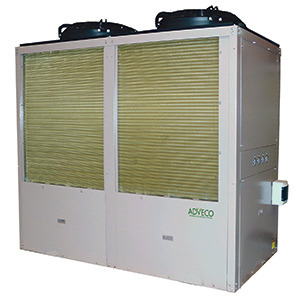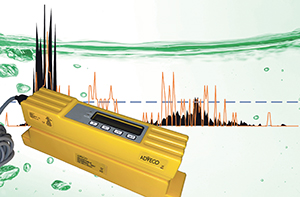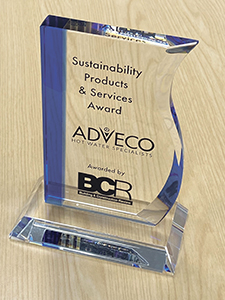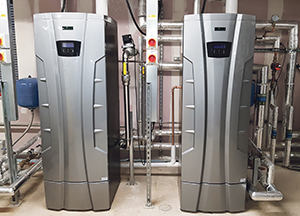BCR Sustainability Products & Services Award Winner Adveco considers the options for introducing low-carbon water heating into commercial properties…
 Buildings are responsible for as much as 50% of the UK’s carbon emissions and addressing hot water generation can affect as much as 30% of a commercial building’s daily energy demands. System choices are typically driven by location, cost, and now increasingly sustainability. The current consensus is that adopting electric water heating is the greener option, but many businesses will wish to retain gas. Either way, it makes sense to add a low-carbon preheat to reduce energy consumption and in turn, reduce carbon emissions and control running costs. Through a mix of cost and simplicity, the best technologies to use to preheat domestic hot water (DHW) systems are either air source
Buildings are responsible for as much as 50% of the UK’s carbon emissions and addressing hot water generation can affect as much as 30% of a commercial building’s daily energy demands. System choices are typically driven by location, cost, and now increasingly sustainability. The current consensus is that adopting electric water heating is the greener option, but many businesses will wish to retain gas. Either way, it makes sense to add a low-carbon preheat to reduce energy consumption and in turn, reduce carbon emissions and control running costs. Through a mix of cost and simplicity, the best technologies to use to preheat domestic hot water (DHW) systems are either air source
heat pumps (ASHP) or solar thermal.
 Air To Water
Air To Water
Heat pumps are a technology that operates most efficiently at lower temperatures, making it highly applicable to domestic applications, but commercial DHW systems require 60°C working flow for safe (anti-legionella) operation. Commercial heat pumps, such as the Adveco FPi32 & L70 ranges, can be pushed to deliver a higher percentage contribution, generating temperatures of 45-50°C for preheat. But this is at the cost of performance efficiency, drawing in more electrical energy. Compared to an equivalent-sized direct-electric (ie, from the grid) system, one with an ASHP can achieve carbon reductions of 42-47%, whilst saving 25-35% of the energy costs. The system will still be required to top up heat to the necessary 60°C, using either immersion or an electric boiler. This, combined with the heat pump’s reduced operational efficiency means it will still be much more expensive to run than an equivalent-sized gas-fired system based on a modern and efficient (109% net) water heater.
The recommendation in this case is to keep electrical demand down by increasing the size of the hot water storage which is then heated more slowly. This is very different to the high energy input, low storage seen with gas-fired systems. A 30kW energy source can heat 750 litres/hour by 34°C, so when the system draws hot water at a faster rate than it can be heated to 44°C for hot showers you start to get complaints that the water is ‘cold.’ The larger volume cylinder helps to overcome this undersizing allowing for a two hour reheat cycle that maintains enough water at 60°C to meet daily demand, whilst slowly heating reserves through the night when demand is minimal to meet the morning peak.
 Even so, gas-based hot water applications are, by a factor of 3.8, still cheaper to operate than direct grid-electric systems. Using heat pumps can offset energy costs, but this still leaves a considerable excess operating charge because of the need to provide top-up energy for safe operating temperatures. Historically, additional system top-up was provided by electric immersions, which for backup purposes and occasional peaks in demand whilst more expensive was acceptable. The shift to fully electric systems has put a greater onus on the technology which was never designed to provide primary heat. The costs are excessive and should they be deployed hard water, can rapidly develop scale leading to permanent damage in a remarkably short time. For this reason, we recommend the replacement of immersion technology with smaller electric boilers, such as Adveco ARDENT, that are both more efficient, and, because they operate in a closed loop will avoid the issues of systems scaling up.
Even so, gas-based hot water applications are, by a factor of 3.8, still cheaper to operate than direct grid-electric systems. Using heat pumps can offset energy costs, but this still leaves a considerable excess operating charge because of the need to provide top-up energy for safe operating temperatures. Historically, additional system top-up was provided by electric immersions, which for backup purposes and occasional peaks in demand whilst more expensive was acceptable. The shift to fully electric systems has put a greater onus on the technology which was never designed to provide primary heat. The costs are excessive and should they be deployed hard water, can rapidly develop scale leading to permanent damage in a remarkably short time. For this reason, we recommend the replacement of immersion technology with smaller electric boilers, such as Adveco ARDENT, that are both more efficient, and, because they operate in a closed loop will avoid the issues of systems scaling up.
Despite this, carbon savings and costs are no longer aligned. However, we can still take advantage of solar thermal which can be employed to offset energy use in gas-fired systems as well as offsetting costs in electric/ASHP applications.
 The Power Of The Sun
The Power Of The Sun
Solar thermal systems are ideal for businesses that use and rely on large amounts of hot water, but it is important to understand that a solar thermal system will not fully replace your existing water heating system and will not provide space heating.
The actual percentage of your water heating demand covered by solar thermal will depend on your site and energy consumption habits (though this figure is typically around 30% for commercial sites). Sized and installed correctly, a single solar thermal collector can contribute up to 1400kWh per annum, providing electricity savings of £300 and more importantly reducing emissions of CO2 by 322kg.
Incorporating Drain Back, a feature of all Adveco solar thermal systems, helps prevent stagnation of solar fluid in the collector which would lead to costly repairs. This gravity flow approach reduces pump capacity requirements and energy use of the pump station to a minimum and will automatically drain fluid if power is cut without the need for working components.
This makes solar thermal systems with drainback low maintenance with long operational lifespans.
 A Future Built On Electric?
A Future Built On Electric?
If your building has a grid connection and has high hot water demands gas remains the most cost-effective option. Additionally, new gas-fired appliances operate with ever-reduced emissions, and most, such as Adveco’s ADplus and AD water heater ranges, and MD boiler range are ready to accept the initial proposed 20% hydrogen blends in the gas grid as early as 2024 without requiring any alteration. Should hydrogen be accepted by the government as a function of net zero we would not expect 100% feeds to be in place nationally until 2040 with the grid changeover beginning in the early to mid-2030s. Retaining an existing gas connection, therefore, provides a degree of futureproofing should green gas technology be embraced.
Perhaps the most detrimental issue we see today as a result of replacing gas with electricity is the propensity to oversize the new electric system, replacing gas appliances with electric alternatives with like-for-like capabilities resulting in unnecessary capital costs for system supply and installation. If an oversized system exceeds a building’s available amperage of electrical supply, project installation costs will inevitably soar, or even stall the project.
This can best be avoided by understanding your building’s actual hot water demands and designing the replacement to meet those specific needs. There is an art to designing hot water systems, but real, actionable data is priceless. When considering options for introducing sustainability the best advice we can give is to understand your needs first. Adveco’s Live Metering service is an easy, non-intrusive way of securing the valuable operational data you need to make a more informed decision that delivers on expectations to lower carbon emissions without incurring unforeseen costs.
